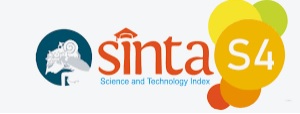Uji Akurasi Algoritme K-Nearest Neighbor Dan Naïve Bayes Dalam Klasifikasi Kelayakan Pemberian Kredit Perbankan
Abstract
Banking credit is a process of giving money or debt following an agreement between the borrower and the bank, as well as determining the classification of creditworthiness on housing loans (KPR). This affects the customer's waiting time for the results of a bank's decision, the success of a bank's credit management will greatly affect the fate of many customer funds if the analysis is inaccurate, so technology is needed to find hidden information on prospective borrowers' data to predict a customer's loan repayment ability. This study uses an algorithm K-Nearest Neighbor and Naïve Bayes to determine the eligibility classification for bank lending and determine the accuracy of bank credit eligibility for mortgages, to determine the accuracy of the algorithm through three stages of testing, namely several preprocessing stages starting from checking duplicates, deal with missing value, deal with outliers, do label encoding, deal with data imbalance use method SMOTE, and standardize using scaler standard. The results of the Naïve Bayes and KNN algorithms as well as the model stages are evaluated to examine each stage in the data for the model's ability to predict, the evaluation matrix used is in the form of a results confusion matrix. There is the best result, namely the KNN algorithm in the third test with a value of K = 10 with a performance of 80.92% training data accuracy and 78.86% testing data and getting a score confusion matrix TP 76 and TN 21.
Keywords: Banking Credit; Data Mining; Machine Learning; K-Nearest Neighbors; Naïve Bayes.
Abstrak
Kredit perbankan suatu proses pemberian uang atau hutang sesuai dengan kesepakatan antara peminjam dengan bank, serta menentukan klasifikasi kelayakan kredit pada Kredit Pemilikan Rumah (KPR). Hal ini mempengaruhi waktu tunggu nasabah atas hasil keputusan bank, keberhasilan pengelolaan kredit suatu bank akan sangat mempengaruhi nasib banyak dana nasabah jika analisisnya tidak akurat, sehingga dibutuhkan teknologi untuk menemukan informasi tersembunyi data calon peminjam untuk memprediksi kemampuan pembayaran pinjaman nasabah. Penelitian ini menggunakan algoritme K-Nearest Neighbor dan Naïve Bayes untuk menentukan klasifikasi kelayakan pemberian kredit perbankan dan mengetahui tingkat akurasi kelayakan pemberian kredit perbankan pada KPR, untuk mengetahui tingkat akurasi algoritme melalui tiga tahap pengujian, yaitu dilakukan beberapa tahapan preprocessing mulai dari pengecekan duplicate, menangani missing value, menangani outliers, melakukan label encoding, mengatasi data imbalance menggunakan metode SMOTE, dan melakukan standarisasi menggunakan standar scaler. Hasil dari algoritme Naïve Bayes dan KNN serta tahapan model di evaluasi untuk memeriksa setiap tahap pada data terhadap kemampuan model dalam memprediksi, matrik evaluasi yang digunakan berupa hasil confusion matrix. Terdapat hasil terbaik yaitu pada algoritme KNN di pengujian ketiga dengan nilai K=10 dengan performa akurasi data training 80.92% dan data testing 78.86% dan mendapatkan score confusion matrix TP 76 dan TN 21.
Â
Keywords
References
D. A. Kurniawan and D. Kriestanto, “Penerapan Naive Bayes Untuk Prediksi Kelayakan Kredit,†JIKO (Jurnal Inform. dan Komputer), vol. 1, no. 1, pp. 19–23, 2016, doi: 10.26798/jiko.2016.v1i1.10.
S. Kosasi, “Aplikasi Pemberian Kredit Pada Bank Kalbar Pemangkat Menggunakan Metode Case Based Reasoning,†Semin. Lokal Inf., pp. 30–37, 2013.
F. Hadi, “Penerapan Metode Algoritme C4.5 dalam Menganalisa Pegajuan Kredit pada Koperasi Jasa Keuangan Syariah Kelurahan Limau Manis Selatan,†Indones. J. Comput. Sci., vol. 7, no. 1, pp. 28–42, 2018, doi: 10.33022/ijcs.v7i1.58.
A. U. Budi Santosa, “Data Mining dan Big Data Analytics Teori dan Implementasi menggunakan Python & Apache Spark Edisi 2,†in Data Mining dan Big Data Analytics Teori dan Implementasi menggunakan Python & Apache Spark Edisi 2, Penebar Media Pustaka, 2018.
H. Leidiyana, “Penerapan Algoritme K-Nearest Neighbor Untuk Penentuan Resiko Kredit Kepemilikan Kendaraan Bermotor,†J. Penelit. Ilmu Komputer, Syst. Embed. Log., vol. 1, no. 1, pp. 65–76, 2013.
R. Wajhillah, I. H. Ubaidallah, and S. Bahri, “Analisis Kelayakan Kredit Berbasis Algoritme K-Nearest Neighbor (Studio Kasus: Koperasi AKU),†InfoTekJar (Jurnal Nas. Inform. dan Teknol. Jaringan), vol. 4, no. 1, pp. 121–125, 2019, doi: 10.30743/infotekjar.v4i1.1264.
R. E. Putri, Suparti, and R. Rahmawati, “Perbandingan Metode Klasifikasi Naãve Bayes Dan K-Nearest Neighbor Pada Analisis Data Status Kerja Di Kabupaten Demak,†J. Gaussian, vol. 3, no. 4, pp. 831–838, 2014.
L. Hakim, “Prinsip Kehati-hatian pada Lembaga Perbankan dalam Pemberian Kredit,†J. Keadilan Progresif, vol. 9, No 2, no. 2, pp. 164–176, 2018.
Jiawei Han;Micheline Kamber;Jian Pei, “Data mining: Data mining concepts and techniques,†International Conference on Machine Intelligence Research and Advancement, ICMIRA 2013. p. 740, 2014, doi: 10.1109/ICMIRA.2013.45.
S. Müller, A., & Guido, Introduction to Machine Learning with Python: A Guide for Data Scientists 1st Edition. O’Reilly Media, 2018.
F. Ramadhana, F. Fauziah, and W. Winarsih, “Aplikasi Sistem Pakar untuk Mendiagnosa Penyakit ISPA menggunakan Metode Naive Bayes Berbasis Website,†STRING (Satuan Tulisan Ris. dan Inov. Teknol., vol. 4, no. 3, p. 320, 2020, doi: 10.30998/string.v4i3.5441.
A. Géron, Hands-On Machine Learning with with Scikit-Learn & TensorFlow : Concepts, Tools, and Techniques to Build Intelligent Systems. O Reilly, 2017.
W. Y. Ayele, “Adapting CRISP-DM for idea mining a data mining process for generating ideas using a textual dataset,†Int. J. Adv. Comput. Sci. Appl., vol. 11, no. 6, pp. 20–32, 2020, doi: 10.14569/IJACSA.2020.0110603.
F. Martinez-Plumed et al., “CRISP-DM Twenty Years Later: From Data Mining Processes to Data Science Trajectories,†IEEE Trans. Knowl. Data Eng., vol. 33, no. 8, pp. 1–14, 2021, doi: 10.1109/TKDE.2019.2962680.
R. Rozaq, “Klasifikasi Penyakit Dengue Menggunakan Algoritme K-Nearest Neighbors Berbasis Flask,†Remik (Riset dan E-Jurnal Manaj. Inform. Komputer), vol. 6, no. 3, pp. 359–369, 2022, doi: 10.33395/remik.v6i3.11501.
R. Abdulloh, Web Programing is Easy. PT Elex Media Komputindo, 2015.
Provost & Fawcett, Data Science for Business What You Need to Know About Data Mining and Data-Analytic Thinking. O’Reilly Media, 2013.
S. Aisyah, Interviewee, Wawancara Variabel Dominan dalam penentuan kelayakan pemberian kredit. [Interview]. 07 November 2022.
"BNI Kredit Digital e-Form," PT. Bank Negara Indonesia (Persero) Tbk, [Online]. Available: https://eform.bni.co.id/BNI_eForm/index.html. [Accessed 06 December 2022].











